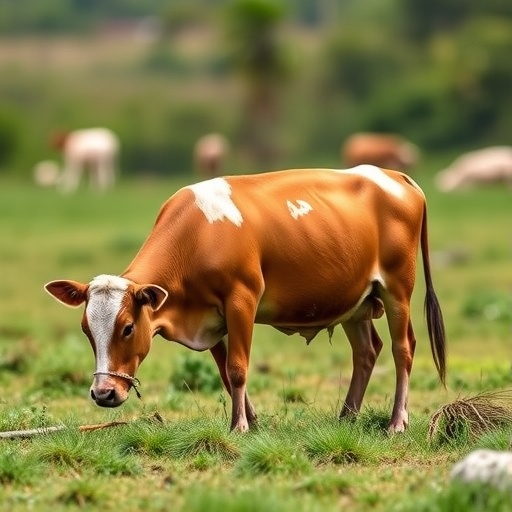Across the global agricultural landscape, livestock production stands as a vital contributor to food security and rural livelihoods, yet it also remains a significant source of greenhouse gases, chiefly methane. Methane’s potent global warming potential—approximately 28 times greater than carbon dioxide over a 100-year period—has positioned it at the forefront of climate mitigation strategies within the livestock sector. Addressing this challenge, a novel project named Time2Graze is pioneering a data-driven solution aimed at curbing methane emissions through optimized grazing management in the tropics of Latin America.
Time2Graze emerges as an interdisciplinary initiative leveraging cutting-edge Earth Observation technologies, sophisticated pasture growth models, and decades of local agricultural knowledge to create a comprehensive decision-support system (DSS) tailored for tropical grazing systems. This tool is designed to empower farmers by delivering timely, actionable insights on pasture availability, thus enabling them to strategically determine optimal grazing periods. The precise timing of grazing can profoundly affect forage regrowth, animal intake, and consequently, the methane emissions intensity relative to protein output.
Methane emissions from enteric fermentation in ruminants constitute a pressing concern due to their significant contribution to anthropogenic greenhouse gas inventories. However, within this domain lies a nuanced opportunity: sustainable forage management can alter the dynamics of feed intake and digestion, potentially lowering methane release per unit of livestock product. Time2Graze directly targets this nexus by embedding ecophysiological understanding of tropical forage species into predictive models that map pasture biomass in real time.
The initial phase of Time2Graze concentrates on two key forage genera prevalent in Latin America’s tropical agroecosystems: Urochloa, commonly known as Brachiaria, and Megathyrsus, known as Panicum. These species underpin livestock diets across diverse livestock systems, from smallholder farms to extensive ranching operations. Accurate, localized data on their growth cycles and nutritional status enables the DSS to forecast optimal grazing windows, balancing forage availability with animal needs and environmental constraints.
Crucially, the development process of Time2Graze is rooted in participatory design. Collaborations with local producers, agricultural extension agents, and governmental bodies in Colombia and Brazil ensure that the DSS outputs address on-the-ground realities and farmer decision-making processes. This approach fosters user trust and adoption potential, mitigating a common barrier faced by digital agricultural solutions in developing contexts.
Technically, the platform integrates satellite remote sensing data—capturing vegetation indices, soil moisture levels, and weather patterns—with pasture growth simulations calibrated to tropical forage physiology. These dynamic data layers feed into machine learning algorithms that generate pasture condition alerts and predictive scenarios. Farmers receive these insights via accessible digital interfaces, allowing them to adjust grazing intensity and timing to optimize forage utilization and minimize overgrazing-related degradation.
By enabling precision grazing, Time2Graze aims to simultaneously enhance livestock productivity and environmental sustainability. Increasing the efficiency of pasture use can lead to improved animal weight gain and milk production while reducing the methane emissions intensity per kilogram of meat or milk produced. This dual benefit aligns with broader efforts to create climate-smart livestock systems that bolster rural resilience in the face of climate variability.
Moreover, Time2Graze addresses critical data gaps that have historically limited evidence-based grazing management in the Global South. Farm-level data scarcity hampers not only local decision-making but also constrains the alignment of international climate finance with effective mitigation practices on the ground. Through its participatory co-design and multi-stakeholder engagement, Time2Graze establishes a replicable model for integrating digital agriculture with climate action.
The implications extend beyond environmental metrics. By improving pasture management, Time2Graze supports socio-economic objectives, including increased farmer income stability and food security. It also contributes to biodiversity conservation by promoting sustainable land-use practices and reducing pressures on natural ecosystems through more efficient pasture utilization.
Looking ahead, expansion plans include adapting the DSS for other tropical forage species and diverse agroecological zones across the Americas and potentially other tropical regions. Continuous refinement leveraging user feedback and advances in remote sensing technology will enhance precision and predictive accuracy, keeping the tool responsive to evolving climatic and agronomic conditions.
In an era where agriculture must reconcile productivity with planetary health imperatives, Time2Graze exemplifies the transformative potential of science and technology. By harnessing multidisciplinary expertise and centering farmer agency, it charts a pathway toward low-emission, resilient livestock systems integral to sustainable development in tropical regions.
Subject of Research: Sustainable grazing management to mitigate methane emissions in tropical livestock systems
Article Title: Time2Graze: Harnessing Remote Sensing and Decision Support Systems for Climate-Smart Tropical Pasture Management
News Publication Date: September 10, 2025
Web References:
- Global Methane Hub announcement on enteric fermentation research strategy: https://www.globalmethanehub.org/2024/08/26/enteric-fermentation-rd-accelerator-launches-research-strategy-to-advance-breakthroughs-in-livestock-methane-mitigation/
Image Credits: CIAT/Isabela Salazar
Keywords: methane mitigation, livestock emissions, tropical forages, grazing management, remote sensing, decision support system, sustainable agriculture, climate-smart livestock, Urochloa, Megathyrsus, Earth Observation, Latin America




